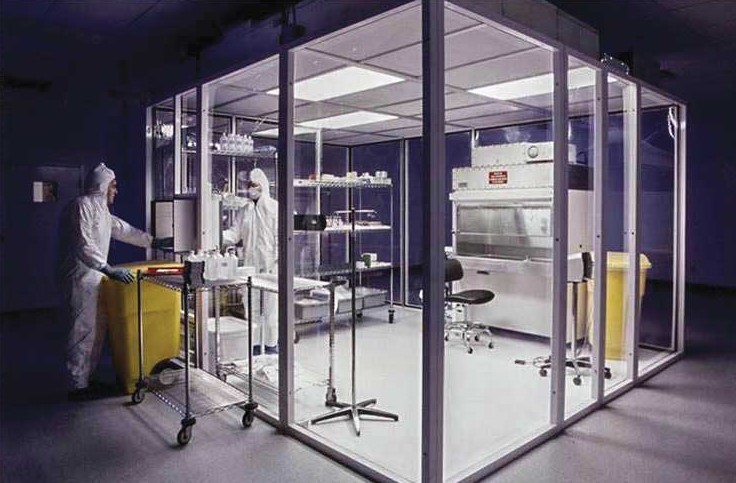
Choosing a system
A best practice is to first evaluate a facility’s security and/or environment control objectives to help determine the level of door interlock solution required. For example, data centers typically require a higher level of security than general office buildings, as specific security restrictions, such as entering a facility with portable memory devices, would not pertain. Door interlock systems for clean rooms may entail numerous sensors to monitor air pressure or temperature before granting access.
Door interlocks are also available with different modes of functionality. An office building with a high amount of pedestrian traffic in the morning and late afternoon may want two doors operating during these periods with the flexibility to switch to a single door during midday hours.
Many door interlocking systems also include intercom communications between the person(s) inside the “mantrap” and a security guard or operator. Advanced configurations are also deployed with biometrics that read faces, eyes, or fingerprints to provide accurate identity verification, adding a much higher level of sophistication and security.
In many instances, the door interlock system must also be discreet and user friendly, or it can become a logjam for pedestrian traffic. A system should allow users to pass through with little effort and in comfort. Working with a reputable manufacturer with in-house capabilities can help ensure the project achieves its goals for ease of operation and specific door interlock capabilities.
With their high degree of programmable operations, door interlock systems are often subject to specific building code requirements. Some municipalities may not allow any doors in a public facility to be locked at any time. While this scenario is intended to provide personnel safety, door violations can become a common occurrence and even a hazard. In some instances, this has been addressed with the use of red/green traffic lights mounted on either side of the doors to indicate when access is allowed. Adding a built-in sounder which annunciates a door violation can minimize access violations.
In an emergency, the door interlock system must also enable people to evacuate the facility. For example, if the power fails, an emergency override handle would ensure the door can be opened manually. Further, life safety codes may require that the door interlock systems be integrated with the facility’s fire alarm control panel to allow emergency door release. A local emergency pull station may be required to allow doors to be unlocked in non-fire alarm emergencies or to interface the system with the National Fire Protection Association (NFPA) 101, Life Safety Code, delayed egress controls.
Installation guidelines
Local building inspectors should always be consulted before installation of a door interlock locking system to help ensure compliance. There are situations where any locks restricting an exit are simply not permitted. In these systems, only traffic lights may be deployed to indicate when entry or exit is permitted. The traffic lights are a visual indication to control traffic; often a buzzer is integrated into the system to audibly warn if there
is a traffic light violation.
Selecting the proper interlock controller
Another consideration when choosing a door interlock system is the interlock controller. The number of doors, types of doors, and other monitored and/or controlled devices all play into the equation when evaluating an interlock controller.
While totally independent interlocking doors can be controlled from a single PLC controller, the distance separating the doors can limit the number of doors per controller. This can complicate the design and deployment of a door control system. Inputs to be monitored by the controller must also be accessed. Monitored devices and operations should include door status, latch monitor, maglock bond sensor, the request-for-access device, card access lock relay, and local push button or other REX device. Doors which are normally unlocked require only a door position switch. Other monitored devices could include emergency override stations and tailgate detectors. All inputs must be dedicated dry contacts, not shared with other systems, and if required, input devices can be mirrored with PLC relay outputs.
Outputs (relays and powered outputs) can be used to operate the electric locking devices, indicator lights, and alarm sounders, and to signal other systems (card access, guard station consoles, etc.). At least one output relay is required for each controlled door to operate the electric lock. The lock relay contacts can also be used to signal door access status. If the doors are normally unlocked, indicators should follow the lock status (i.e. red = locked/green = unlocked). When doors are normally locked, most systems utilize traffic lights to indicate when access may be inhibited (red = access not allowed/green = available for access) as doors may be locked awaiting authorization from the card access system or when the door is not currently available for access because another door is in use.
There are numerous commercial and industrial access applications for door interlock systems, ranging from systems with as few as two doors to systems with several doors, as well as highly specialized vehicular applications, such as armored cars or prison carriers. In many cases, door interlock systems provide a highly efficient and effective solution for myriad security and environmental control applications.
Bryan Sanderford is the national sales manager for Dortronics Systems Inc. Sanderford has extensive hands-on experience with access control products. Prior to joining Dortronics in 1998, Sanderford had 10 years of experience as an installing dealer of access control systems, coupled with nine years as an independent sales representative of security products. He has played an instrumental role in driving the development of numerous electronic locking systems products and technologies marketed under the Dortronics brand name. Sanderford has been active in the access control and security industry since 1977. He is a longstanding member of the Security Industry Association (SIA). He can be reached at bryan@dortronics.com.




